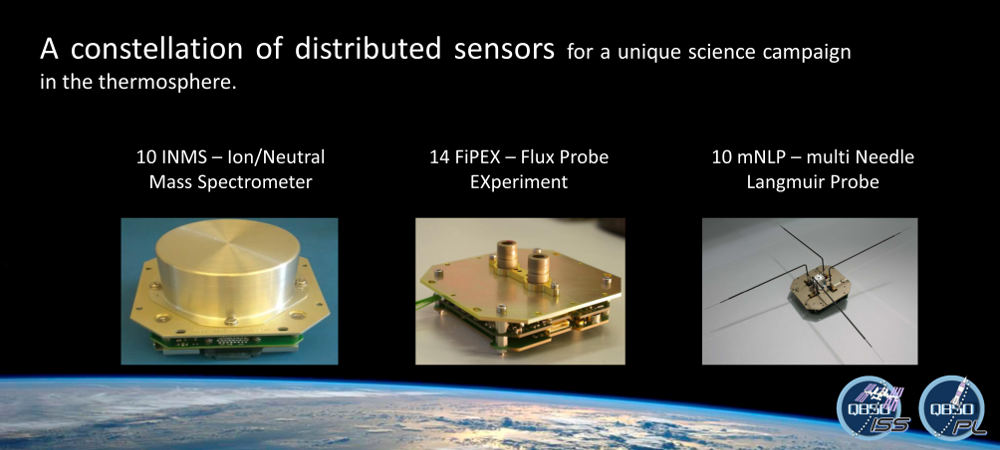The network of QB50 mini-satellites or CubeSats is joining space this Thursday. It is leaving the ISS to join the thermosphere. The deployment is a culmination of work of more than 50 universities and research institutes, 23 countries, and 5 continents. The project, coordinated by an international consortium, receives funding from the European Union’s Seventh Framework Programme for Research and Technical Development*. The QB50 mission is a world premiere, the first study of the thermosphere, a largely unexplored zone.
This morning, the State Secretary for Science Policy, Ms. Zuhal Demir and Ms. Florence Beroud, project officer of the Research Executive Agency (EC) were at VKI to witness the deployment of the first nano satellites of the QB50 network.
“The space policy of the Belgian authorities has put our research institutes in the ideal position to be selected to coordinate important European projects. By its international character, the von Karman Institute is well placed to manage European projects such as QB50. The role of coordinator is a recognition of the expertise of VKI and of the unique role the Institute plays in the education of engineers and in the execution of innovative scientific research projects.”
The CubeSats are fully functional miniaturized satellites made up of double or triple cubic units (10x10x10cm). CubeSats have a mass less than 1.33 kilograms per unit and use off-the-shelf electronic components. The nano-satellites have been designed to facilitate access to space research at lower cost.
The QB50 network is composed of 36 CubeSats. A first rocket that took a part of the QB50 constellation in space lifted off with success early on 18 April 2017 from the launch Pad at Cape Canaveral in Florida.
28 CubeSats reached then the International Space Station. Since Thursday the CubSats are deployed in space. The CubeSats (contained in their dispenser) are installed by an astronaut on the sliding table of the Japanese Experimental Module (developed by JAXA). The table with the dispenser is moved outside of the Station via the airlock. The dispenser is then grabbed by the robotic arm and moved into the correct position for deployment. Each dispenser hosts between 1 and 3 QB50 CubeSats, which are released into orbit at the same time by a command from ground (with a pause of minimum 3 hours between each command). The launch of the 8 remaining CubeSats is foreseen by the end of May.
“On board of the ISS, a universal collaboration is essential for success. Teaming worldwide is key for reaching the challenging goals awaiting humankind inside and outside of our solar system. We are proud to contribute to this international effort”, explained Thomas Pesquet, astronaut on the ISS, who is in charge of the QB50 deployment.
This project represents a unique collaboration between universities and research institutes from 23 countries around the world. The project, coordinated by an international consortium, receives funding from the European Union’s Seventh Framework Programme for Research and Technical Development*. QB50 has the objectives that include facilitating access to space for universities and research centers, performing measurements in the thermosphere, demonstrating new technologies in orbit and promoting space collaboration and science education.
Towards the largely unexplored area: the thermosphere
The QB50 mission is a world premiere. The project is the first attempt to provide multi-point measurements of the upper layers of the atmosphere, the mid-lower thermosphere, located between 200km and 400 km altitude, through a constellation of CubeSats. This area of the thermosphere is the least explored mainly because it is difficult or risky to reach. It is too high in altitude to be reached by ground radar and small rockets and it is too low for satellites. In fact, this area is important to accurately determine the reentry trajectory of a spacecraft.
After deployment, the CubeSats of the QB50 constellation will initiate their long descent. While orbiting around the Earth several times a day, the CubeSats will take a large number of measurements of the gaseous molecules and electrical properties of the thermosphere. The data will be centralized by the von Karman Institute and will serve to better understand the relation between the Earth’s atmosphere and the Sun radiation. The results generated by the constellation will be used to validate and enhance forecasting models and improve our understanding of the physical processes taking part in the thermosphere. The CubeSats flying in the thermosphere will have a very short lifetime, between 1 to 2 years, before completely burning up in the atmosphere.
The data generated by the constellation will be unique in many ways and they will be used for many years by scientists around the world.
Some key figures
QB50 involved more than 50 professors and 300 students. Its budget reached 9 million EUR, a fraction of the cost of a conventional space mission. Today more than 1000 pages documentation were produced and reviewed.













 The project was executed to an unprecedented timeline. Formal Kick-Off was in October 2013 and all hardware from the different partners was delivered for integration into the satellites in January 2014. This means that two satellites were delivered in just over 6 months. Furthermore, with a precursor launch scheduled in June, launch and operations will commence within 9 months of project Kick-Off.
The project was executed to an unprecedented timeline. Formal Kick-Off was in October 2013 and all hardware from the different partners was delivered for integration into the satellites in January 2014. This means that two satellites were delivered in just over 6 months. Furthermore, with a precursor launch scheduled in June, launch and operations will commence within 9 months of project Kick-Off.
